Field Notes
010
Round and Round We Go
The furor over the Elgin Marbles heats up!
ArtWatch UK, a British group that monitors the restoration of works of art, has charged that in the 1950s Greek restorers badly damaged marble sculptures from the Hephaesteum (a fifth-century B.C. temple in the Athenian Agora dedicated to the gods Hephaestus and Athena) in an attempt to clean them. These charges came as a team of Greek archaeologists were about to issue a report confirming that the British Museum had conducted a similarly damaging cleaning of some of the Elgin Marbles in the late 1930s.
This most recent flurry of accusations, however, has less to do with past mistakes than with the question, Should the Elgin Marbles remain in the British Museum?
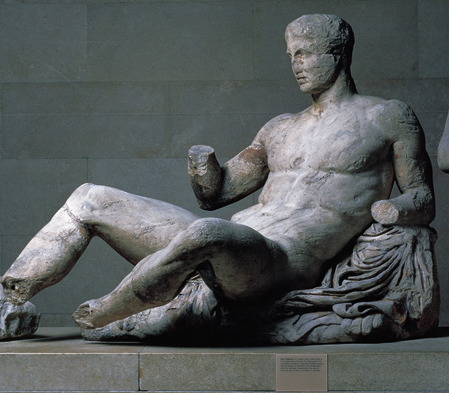
The Elgin Marbles are a group of marble carvings removed from the Parthenon, the fifth-century B.C. temple of Athena on the Athenian Acropolis, by the Scotsman Thomas Bruce, the seventh earl of Elgin. Between 1799 and 1801, while serving as British ambassador to the Ottoman Empire (which then ruled Greece), Lord Elgin extracted 18 life-size pediment statues (including the carving of Theseus above), 15 metope panels and 56 frieze panels (a 247-foot stretch of marble) from the temple and shipped them to London. In 1816 Elgin sold the marbles to the British Museum for £35,000, where they have remained ever since (see Jacob Rothenberg, “Lord Elgin’s Marbles,” AO 01:02).
Until a couple of decades ago, the marbles aroused mostly rapture. The 19th-century British poet John Keats, for example, described them as a “sun, a shadow of a magnitude [divinity].” In the 1980s, however, they became controversial, largely due to the popular Greek actress Melina Mercouri. An engaging supporter of Greek causes and a hero of the resistance movement against the Greek military regime (1967–1974), Mercouri served as minister of culture from 1981 to 1989 and again from 1993 until her death in March 1994. During her first tenure, she announced that the Greek government would actively campaign to have the marbles returned to Athens, where they would be housed in a new Acropolis Museum. (This museum is not yet completed.)
The Mercouri campaign set in motion a furious debate about the proper home of the Elgin Marbles (see “An Odyssey Debate: The Elgin Marbles,” AO 01:02). Those who believe the marbles should be repatriated argue that the Parthenon is the greatest monument of Greek culture and the most prominent symbol of Greek national identity—so it is only right that its parts be gathered together and displayed in one place: Athens. Those who believe the marbles should remain in the British Museum argue that the marbles were legally acquired and have been well preserved, while other Parthenon sculptures have suffered from vandalism, neglect and exposure to Athens’s pollution.
The British position took a blow in June 1998, when Oxford University Press published a revised edition of the classic study Lord Elgin and His Marbles by British historian William St. Clair. Citing documents kept secret for 60 years, St. Clair reported that in 1937 and 1938 British Museum curators improperly attempted to clean a number of the marbles by scraping them with copper tools and sanding them with carborundum. The members of a 1938 meeting of the British Museum Standing Committee concluded that due to “unauthorised and improper efforts to improve the colour of the Parthenon sculpture[s] … important pieces had been greatly damaged.” When museum officials realized that carvings had been disfigured, St. Clair recounted, they authorized attempts to conceal the damage by staining them with colored wax.
Claiming that documents relating to the botched cleaning fell under British secrecy laws, the museum refused to release the information to the public. St. Clair repeatedly pressed museum officials to release the papers, noting that the 30-year confidentiality period had expired. In 1996 the museum complied.
Once St. Clair’s charges became known, the Greek government arranged for a team of archaeologists to investigate the matter. Their conclusions appeared in a 100-page report presented in November 1999. The report stated that the museum’s 1937–1938 cleaning had “tortured” the statues “barbarously.” The Greek Minister of Culture, Elisavet Papazoi, publicly stated that the Greek team’s conclusions provided even more reason to return the marbles “to their natural environment” on the Acropolis.
Even before the report was released, however, countercharges were being leveled in the British media. In a November 4, 1999, interview with the London Times and in the December/January 2000 issue of the journal Art Review, the British artist Michael Daley, who is 011also the director of ArtWatch UK, reported that in 1953 marble sculptures on the Hephaesteum were damaged during a similar kind of cleaning; the temple’s frieze was scrubbed with wire brushes and scraped with steel chisels after being repeatedly soaked in hot and cold water. (The Hephaesteum, formerly known as the Theseum because some of its sculptures depict scenes from the Theseus myth, is often called the Parthenon’s sister temple; it was completed in about 440 B.C., a decade before the Parthenon.)
This “cleaning,” which completely removed the golden-brown patina the frieze had acquired over the millennia, was conducted by two Greek restorers under the supervision of Alison Frantz, an American archaeologist. Frantz published an account of the work in 1954, but her article aroused no controversy at the time.
The real problem, Daley told Archaeology Odyssey in an interview last January, is not that past restorers used faulty methods but that the 1953 restoration “may not have been a one-time occurrence.” Moreover, he said, neglect of the Parthenon and the sculptures not taken by Elgin has left them in an extremely deteriorated state.
“The Elgin Marbles neither will nor should be sent back to Athens,” Daley said. “It is everybody’s good fortune that, through Elgin’s actions, some of the carvings were spared the fate that would otherwise have overtaken them in Athens during the last 200 years.”
Certainly, that is not the last word. Greece has formally asked the British government to return the marbles, as an act of good will, in time for the 2004 Summer Olympic games, which are to be held in Athens. A number of influential people have supported Greece’s moral claim to the carvings. Last November, while strolling among the ruins of the Acropolis, President Clinton told Elisavet Papazoi, the Greek culture minister, “If it were up to me, I would give [the Elgin Marbles] back immediately.” Prince Charles, too, has on repeated occasions stated that the marbles should one day be repatriated to Greece. Even the Turkish foreign minister, Ismail Cem, during a visit to Athens last February (the first such official visit in 40 years), said he fully supported the “Greek government’s effort to have their own properties back.”
And the beat goes on.
011
What Toppled Egypt’s Old Kingdom?
A group of recently excavated skeletons may provide an answer

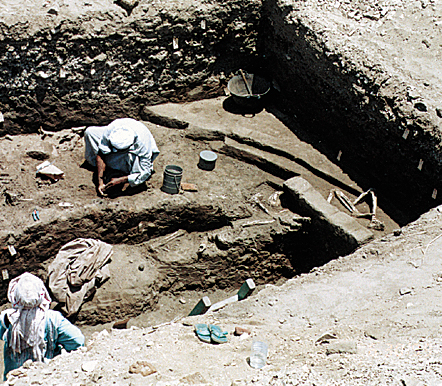
A team of archaeologists from Pennsylvania State University had a nasty shock while excavating the remains of a 4,300-year-old temple in the town of Mendes in northern Egypt. Buried beneath a pile of scorched mudbrick in the temple’s courtyard, they found the battered and twisted remains of 18 corpses. The contorted postures of the bodies suggest that they were probably the victims of a bloody massacre, during which the surrounding temple was also burned to the ground.
“We have no evidence as yet who the perpetrators were or why they did it,” excavation director Donald Redford told Archaeology Odyssey. Redford suspects that the corpses, which date from the reign of Pepi II (c. 2278–2184 B.C.), may offer the first real proof of widespread social unrest during the final days of Egypt’s Old Kingdom (c. 2575–2134 B.C.).
A handful of ancient Egyptian texts do mention a period of civil strife accompanying the collapse of Egypt’s first great civilization. One 8th Dynasty (c. 2150–2134 B.C.) text refers to the destruction of numerous shrines around the time of Pepi’s reign, and several later documents from Egypt’s Middle Kingdom (c. 2040–1640 B.C.) and New Kingdom (c. 1550–1070 B.C.) lament a time of social collapse and chaos. Historians have offered several possible explanations for the Old Kingdom’s collapse, including a weakening of pharaonic authority and a prolonged drought. “Until now, however, there was no archaeological evidence of these events,” said Redford, who plans to return to Mendes this summer to continue his excavations.
012
Midas‘s Last Supper
The ancient Phrygian king went out with a bang(quet)
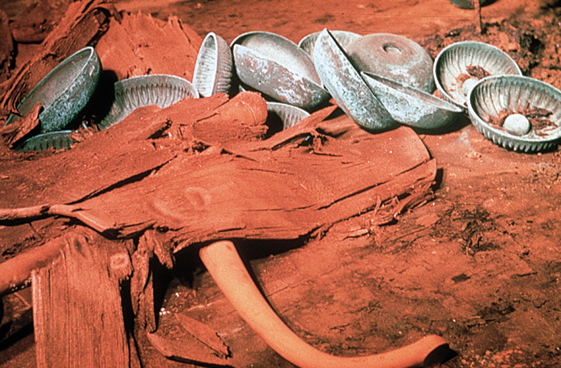
Scientists at the University of Pennsylvania have reconstructed the funeral feast that subjects of the eighth-century B.C. Anatolian king Midas celebrated as their deceased sovereign journeyed into the afterlife.
Most people think of Midas as simply a figure in Greek myth. It was Midas who preferred Pan’s pipes over Apollo’s heavenly lyre—and was awarded a pair of ass’s ears. And it was Midas who wished for the golden touch, and nearly died because of it.
In real life, however, Midas ruled the prosperous, Iron Age Phrygian kingdom, which had its capital at Gordion, about 50 miles southwest of modern Ankara, Turkey. Midas’s Phrygia conducted relations with the Assyrian king Sargon II (721–705 B.C.) in the East and with Greece in the West. According to some stories, Midas took a Greek wife, and the Greek historian Herodotus (c. 484–425 B.C.) wrote that the Phrygian king was the first foreigner to make offerings in the sanctuary of Apollo at Delphi.
When Midas died, around 700 B.C., he was placed in a splendid, wooden burial chamber, along with elaborately inlaid furniture, bronze and brass vessels, and jewelry. Midas’s mourners then covered this chamber with a huge mound of clay and stone, creating a burial tumulus.
In 1957 a team from the University of Pennsylvania Museum, under the direction of Rodney S. Young, excavated Midas’s tomb. They found the skeleton of the king, who had died in his early 60s, resting in a log coffin. Strewn around the king were hundreds of bronze vessels—some still filled with the remains of food and drink.
Were these victuals offerings to the gods, or perhaps intended as sustenance in the afterlife for the dead king? Chemical tests performed on the food in the 1950s and 1960s failed to identify the samples, so they were put aside.
Recently, Elizabeth Simpson, an archaeologist with the Bard Graduate Center for Studies in the Decorative Arts who is studying and preserving the inlaid furniture, resurrected the question of the Midas tomb food samples. Aware that in recent years scientists at the University of Pennsylvania Museum have identified the ancient remains of wine, beer and organic dyes, she suggested that they analyze the Gordion material.
We now know, thanks to the archaeochemist Patrick McGovern and his colleagues at the University Museum, that the food remains in Midas’s tomb were probably leftovers from a huge funeral feast—a kind of gourmet wake, in which the king’s mourners ate, drank and then covered over their sovereign’s tomb for eternity.
We even know the menu: mutton stew. Sheep or goat meat was barbecued and then added to a savory mixture of lentils (or some similar legume), olive oil, honey, wine and fennel (or anise). McGovern’s team also identified the contents of the drinking vessels: The bereaved Phrygians washed down their mutton stew with a fermented concoction of grape wine, barley beer and honey. (Some of the samples were taken from the bronze, ram-headed vat, shown below.)
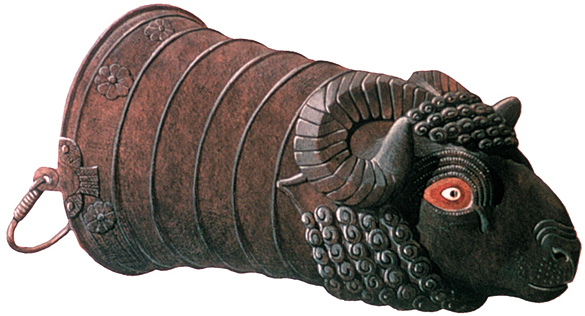
The Phrygians’ choice of drink may even reveal their origins. This people settled in central Anatolia sometime after the collapse of the Hittite Empire (c. 1200 B.C.). By 800 B.C., they had built their capital at Gordion, which contained a citadel protected by massive fortifications. A hundred years later, probably during Midas’s rule, Gordion was overrun by the Cimmerians, a people migrating westwards from the Anatolian steppes south of the eastern Black Sea.
Current excavations at Gordion, under the direction of G. Kenneth Sams of the University of North Carolina, suggest that Gordion remained a Phrygian center—though a weakened one—until about the beginning of the sixth century B.C., when the city was incorporated into Lydia, a power to the east. Then in 547 Gordion was conquered by the Persian emperor Cyrus the Great—and it ceased thereafter to be a Phrygian city.
But who were the Phrygians in the first place? Some archaeologists have argued, from similarities in pottery types, that the Phrygians migrated into central Anatolia from Thrace. The evidence produced by the McGovern team gives some support to that conclusion. The wine-beer-mead tipple found in Midas’s tomb was also popular in parts of Bronze Age Greece, where it was known as kykeon (mixed drink).
The University of Pennsylvania Museum is planning a recreation of the King Midas feast for September 23, 2000. Invitations will be available in August. To receive information about the event through the mail, call 215–898-4890, or visit the museum’s Web Site (www.upenn.edu).
014
Villa Agrippina
Construction workers excavate the home of a first-century A.D. Roman aristocrat
Over the past year, Italian archaeologists found—and then lost again—the remains of a 1,900-year-old villa believed to have been the home of the Roman noblewoman Agrippina.
The villa, on Rome’s Janiculum Hill, was discovered late last summer during the construction of a multistory parking garage for the Vatican. In August, construction workers completing the facility’s lower access ramp—which is on Italian soil—stumbled across a submerged stretch of unbroken wall, brightly painted with floral and architectural motifs.
Janiculum Hill has long been associated with the Horti (Gardens) of Agrippina (14 B.C.–33 AD), whose story is grippingly told in Robert Graves’s novel I, Claudius. The granddaughter of Augustus, Agrippina married the adopted nephew of Tiberius, Germanicus, to whom she bore nine children, including the future emperor Caligula. Agrippina traveled with Germanicus in his campaigns up the Rhine and in the East until he died in 19 A.D. On returning to Rome, Agrippina became involved in political intrigues perceived as a threat by Tiberius, who had her arrested in 29. The Roman senate then banished her to Pandateria, off the coast of Naples, where she starved to death.
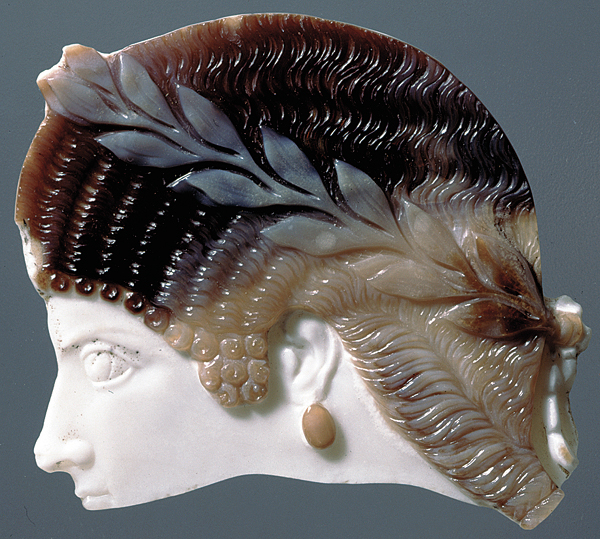
Agrippina’s palatial villa and hanging gardens were later owned by her daughter, Agrippina the Younger (above), who passed the estate on to her son, the emperor Nero (37–68). The younger Agrippina’s story was as woeful as her mother’s. In 49 she married her uncle, the emperor Claudius, and persuaded him to give her the title “Augusta.” She may have poisoned Claudius to make way for Nero, her son by a former marriage. In 59 she was murdered by an assassin acting on Nero’s instructions.
According to the early-second-century A.D. Roman historian Tacitus, the grounds surrounding the villa were also the site of some of Rome’s earliest Christian crufixions, making this holy ground in the eyes of many Christians.
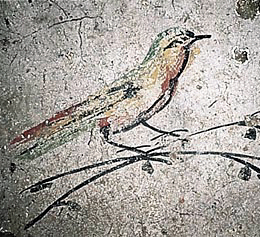
Last September, the Italian Minister of Cultural Heritage, Giovanni Melandri, ordered an indefinite suspension of the garage’s construction to allow Italian archaeologists to excavate the site. Over the next few months, an excavation team uncovered two second-century A.D. rooms decorated with colored masks, birds (above) and floral motifs. They also found column bases, capitals, statue fragments and 30 different types of worked marble. One of the room’s walls featured an example of ancient graffiti, carved in Greek by a visitor to Rome: “The city is beautiful, but this woman did not please me.”
Italian archaeologists had hoped to continue their excavations of the site, but their plans met with stiff resistance from both the Vatican and Roman officials. Most Roman citizens support the construction of the six-story underground facility—quickly dubbed “God’s Garage”—because it promises to relieve the city’s traffic problems. The city government was especially eager to finish the garage in time for the Vatican millennial celebrations. (The city is expecting around 30 million visitors in the year 2000.)
Tensions between the two sides reached a boiling point in early December, when ancient artifacts, very likely relics from the access-ramp site, were found in a local dump—though how they got there is a mystery.
Archaeologists and members of Italy’s Green party immediately organized protests outside the construction site and demanded that all future work on the garage complex be stopped.
Despite the growing controversy, on December 10 the Italian cabinet voted to allow work on the parking garage’s access road to proceed. The Roman government has promised to remove the painted walls and other architectural elements to a museum, but archaeologists remain outraged over what they consider the needless destruction of an important historic site.
Although the cabinet’s decision came too late for the garage to be ready for Rome’s New Year celebration, construction was resumed in late December. The Pope officially blessed “God’s Garage” in a public inauguration ceremony held on January 31, 2000.
A spokesman from the Italian conservation organization Italia Nostra succinctly summed up the episode, “History hid its vestiges in the wrong place.”
015
What Do You Know About The Stone Age?
1) The term “Stone Age” usually refers to what period of human history?
a) 2 million B.C.–3500 B.C.
b) 80,000 B.C.–5,000 B.C.
c) 10,000 B.C.–3000 B.C.
d) 15,000 B.C.–5000 B.C.
2) Approximately how many people were living on the planet in 10,000 B.C.?
a) Less than one million
b) three million
c) five million
d) over 10 million
3) When did Stone Age peoples begin to domesticate plants and animals?
a) 18,000–15,000 B.C.
b) 11,000–8000 B.C.
c) 7000–5000 B.C.
d) 20,000 B.C.
4) Who were the first people known to have domesticated horses?
a) Sioux Indians of North America
b) Hittites of Anatoliac) Sredny Stog of Russia
d) Sumerians of southern Mesopotamia
5) What is the date of the earliest archaeological evidence that humans were using fire to cook meat?
a) 1 million B.C.
b) 400,000 B.C.
c) 250,000 B.C.
d) 40,000 B.C.
6) The earliest Stone Age evidence of copper and bronze has been found in what modern location?
a) Thailand
b) Egypt
c) Japan
d) Peru
7) Which of the following tools was not invented during the Stone Age?
a) wedge
b) wheel
c) lever
d) bow and arrow
8) The items below were made by the Neolithic Yarmukians (see “The Yarwhosians?”). What are they?
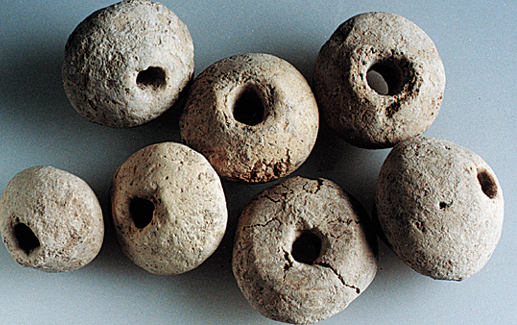
a) earrings
b) millstones
c) anchors
d) spindle whorls
Answers
(1)a (2)b (3)b (4)c (5)b (6)a (7)b (8)d These hand-made clay spindle whorls are 1.5 inches in diameter.
Round and Round We Go
You have already read your free article for this month. Please join the BAS Library or become an All Access member of BAS to gain full access to this article and so much more.
